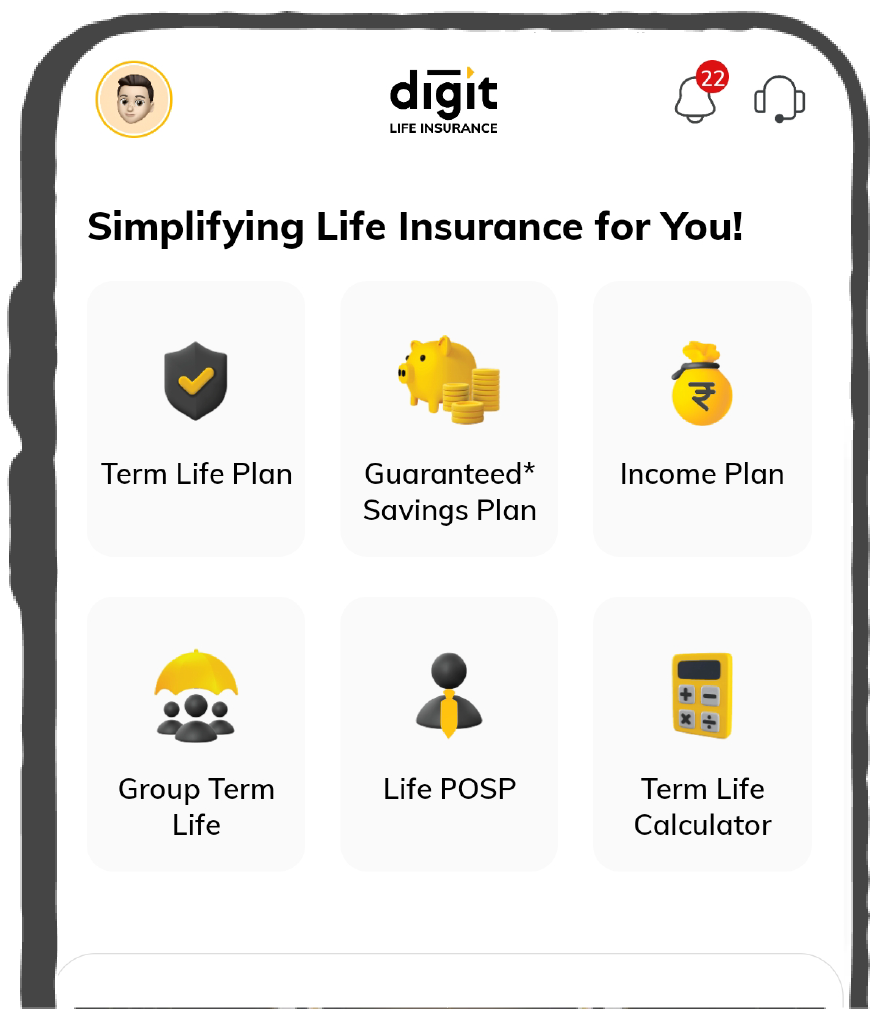HRA Calculator
| Tax Slab | Tax Saving as per Old Regime (Including cess) |
|---|---|
| 5% | ₹5200 |
| 20% | ₹20800 |
| 30% | ₹31200 |
Save up to ₹31200 Tax
with Digit Health Insurance
HRA Exemption Calculator: Calculate HRA Online in 2 Minutes

Struggling to understand how much of your House Rent Allowance (HRA) is actually tax-exempt? You're not alone. Many salaried professionals in India miss out on potential savings due to unclear rules and complex calculations. That’s where an HRA Exemption Calculator comes in — a fast, reliable tool that helps you determine your tax-free HRA in minutes.
Whether you're living in a metro city or a non-metro city, paying rent to your landlord or even to your parents, the rules can be confusing. With our HRA calculator, you can easily calculate your HRA exemption and taxable HRA by entering your salary details, rent paid, and city of residence.
Use our calculator now to know your eligible HRA savings instantly!

Table of Contents

What is HRA Calculator?
Formula to Calculate HRA Exemption
HRA exemption is calculated as per Income Tax Rule 2A. According to this, the least amount of the following is exempted from an employee’s salary under Section 10(13A) and is a non-taxable portion of their income –
- The actual HRA that employees receive from their employer.
- HRA is 50% of the sum of basic salary and DA for metro city employees. For non-metro city employees, it is 40% of the sum of their basic salary and DA.
- Actual rent applicable minus 10% of (Basic salary + DA).
Keep in mind that only the least amount of these provisions is applicable for your HRA exemption.
How to use the Digit’s HRA Calculator?
Manually determining your HRA deduction can be problematic and time-consuming. Digit makes this process simple with its easy-to-use HRA Calculator. Here’s how you can use it:
Enter Your Salary Details
Open the digit's HRA calculator page and fill the appropriate fields with your basic salary amount, dearness allowance earnings, HRA amount and your total rent.
Select Your City
Next, choose whether you reside in a metropolitan city or a non-metro city and verify all the data that you entered once again to prevent any errors.
Calculate your HRA
Finally, click on “calculate” button and know your hra.
Explore Other Calculators that will Help You Save Tax
How Can an HRA Calculator Help You?
An HRA calculator is a simple tool to determine what house rent allowance you can claim as a tax exemption. It automatically applies the basic rules under the Income Tax Act and can provide you with an answer in seconds.
The HRA exemption calculator requires just a few pieces of information to use, which include:
- Your Basic Salary
- HRA as part of your salary
- Rent paid for your home
- Your city
Based on this information, the HRA calculator will compute your eligible exemption. Here is how it helps:
- Clear eligibility: It checks the three big conditions required for HRA exemption: being a salaried employee, paying rent, and having rent greater than 10 percent of salary.
- City-based calculation: Since the HRA exemption differs in a metro city and a non-metro city, the HRA calculator will adjust the amount based on your city.
- No errors: Errors are easy to make when calculating manually. The HRA exemption calculator makes adjustments and saves time.
- Better planning: Knowing your yearly exemption, you can quickly plan for taxes and savings.
Read More
Read Less
How Much of My HRA is Exempt From Tax?
Not all of your HRA is tax-exempt. Under Section 10(13A) of the Income Tax Act, exemption on HRA is allowed only on the minimum of the following three amounts:
- HRA you received from your employer.
- The rent you paid minus 10% of your salary.
- 50% of basic salary if you live in a metro city, or 40% of basic salary in a non-metro city.
Your taxable income will include the excess house rent allowance for which you cannot show an exemption under the above conditions.
Scenario: HRA Exemption Calculation for Priya, who is living in a metro city
Let's consider Priya, a resident of Bengaluru:
- Monthly basic salary: ₹60,000
- Annual HRA from her employer: ₹1,20,000
- Monthly rent: ₹18,000
Now we will see what the three conditions result in:
Disclaimer: The above example is for illustration purposes only. Actual HRA exemption may vary based on your salary structure, city classification, and applicable income tax rules. Always verify with the latest tax guidelines or consult a tax professional.
How is HRA Taxed?
An HRA calculator is a simple tool to determine what house rent allowance you can claim as a tax exemption. It automatically applies the basic rules under the Income Tax Act and can provide you with an answer in seconds.
The HRA calculator requires just a few pieces of information to use, which include:
- Your Basic Salary
- HRA as part of your salary
- Rent paid for your home
- Your city
Based on this information, the HRA calculator will compute your eligible exemption. Here is how it helps:
- Clear eligibility: It checks the three big conditions required for HRA exemption: being a salaried employee, paying rent, and having rent greater than 10 percent of salary.
- City-based calculation: Since the HRA exemption differs in a metro city and a non-metro city, the HRA calculator will adjust the amount based on your city.
- No errors: Errors are easy to make when calculating manually. The HRA exemption calculator makes adjustments and saves time.
- Better planning: Knowing your yearly exemption, you can quickly plan for taxes and savings.
Disclaimer: The example is for illustrative purposes only. Actual HRA exemption depends on your salary structure and current tax rules.
What are the Documents Required to Claim HRA Exemption?
Here are the documents required to claim HRA exemption:
Rent receipts
Rental agreement
Landlord’s PAN (if annual rent exceeds ₹1,00,000)
Proof of rent payment (e.g., bank statement, UPI receipt)
Salary Slip
Form 12BB (for salaried employees)
Eligibility Criteria to Avail HRA Exemptions
Not every salaried employee can claim these benefits while filing taxes, because one needs to meet specific criteria to take advantage of the same. Here are some factors that decide your eligibility for HRA exemptions:
- You must be a salaried employee.
- Your employer must include an HRA component in your monthly payments.
- You have to pay rent to qualify for House Rent Allowance tax benefits.
- You should not own any residential property.
- You should not receive rent from any property that you may own.
As you can understand from the requirements listed above, self-employed individuals cannot claim this tax benefit.
Homeowners can avail of HRA exemptions, along with the applicable tax benefits on home loan interest and principal payments, under two conditions.
You qualify for HRA if your owned property is rented out, but you do not receive the said rent (a family member may receive the rent on your behalf).
Alternatively, you can be a property owner and still claim HRA benefits if you reside in a different city than where your owned property is located.
Read more
Read less
Things to Keep in Mind When Calculating House Rent Allowance Exemptions
When calculating HRA deductions, you must keep the following guidelines in mind:
- Allocated HRA cannot exceed 50% of your basic salary.
- Salaried employees cannot claim for deduction of the full rental amount. Instead, the least amount of the three provisions will be deemed as a suitable exemption.
- Tax benefits of HRA are available alongside home loan tax rebates.
- If annual rent is higher than Rs.1 lakh, your landlord’s PAN card must be presented to claim HRA benefits.
- If you live with your parents, you can pay rent to them and collect an HRA receipt for the transaction. However, you cannot claim HRA benefits by paying rent to your spouse or partner.
- If your landlord is an NRI, you will need to deduct 30% tax from the rent amount before presenting it for HRA deductions.
Calculating your HRA exemption accurately is essential for effective tax planning. Digit’s HRA Calculator simplifies this process by instantly computing the exempt and taxable portions based on your salary, rent, and city of residence. This not only saves time but also ensures compliance with Income Tax rules under Section 10(13A). Start using it today to plan better and make informed financial decisions.













